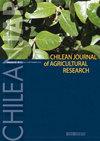Synthesis and characterization of silica nanoparticles from rice husk and their effects on physiology of rice under salt stress
IF 1.7
4区 农林科学
Q2 Agricultural and Biological Sciences
引用次数: 6
Abstract
Silicon (Si) is considered a beneficial element for rice ( Oryza sativa L.) The objective of this work was to investigate the effects of Si in the form of nanoparticles on growth and physiology of rice under salt stress. Silica nanoparticles (SNPs) were synthesized from rice husk by sol-gel method. The prepared SNPs powders were agglomerated in semi-spherical nano-sized particles with diameters in the range of 60-135 nm. Three rice cultivars namely ‘Pokkali’, ‘KDML105’ and ‘IR29’ were grown for 30 d in plastic pots, and then divided into four groups i.e., control, SNPs, NaCl and NaCl + SNPs. Foliar spray of 120 mg L -1 SNPs was given to the SNPs and NaCl + SNPs groups for 4 d. After that the plants in NaCl and NaCl + SNPs groups were exposed to 150 mM NaCl for 17 d. The salt-stressed plants suffered significant reductions in biomass, net photosynthesis rate (P N ), and maximal quantum efficiency of photosystem II (PSII) photochemistry (F v /F m ) while three stress indicators (malondialdehyde, hydrogen peroxide [H 2 O 2 ] and proline) considerably increased. The SNPs mitigated the adverse effects of salt stress by increasing P N (18% to 116% increase) and lowering H 2 O 2 (8% to 31% reduction) in all cultivars, compared with the values under salt stress, while proline was reduced by 7% in ‘KDML105’ and 19% in ‘IR29’. The H 2 O 2 content was regulated by the increased activities of antioxidant enzymes, notably catalase, peroxidase and ascorbate peroxidase. The application method and concentrations of SNPs used for rice plants under stress should be further optimized for the highest benefit of growth and yield in the field conditions.稻壳二氧化硅纳米颗粒的合成、表征及其对盐胁迫下水稻生理的影响
硅(Si)被认为是水稻(Oryza sativa L.)的有益元素。本工作的目的是研究纳米硅对盐胁迫下水稻生长和生理的影响。以稻壳为原料,采用溶胶-凝胶法合成了二氧化硅纳米粒子。将制备的SNPs粉末聚结为直径在60-135nm范围内的半球形纳米尺寸颗粒。三个水稻品种“Pokkali”、“KDML105”和“IR29”在塑料盆中生长30天,然后分为四组,即对照组、SNPs组、NaCl组和NaCl+SNPs组。向SNPs和NaCl+SNP组施用120mg L-1 SNPs的叶面喷雾4 d。之后,将NaCl和NaCl+SNPs组的植物暴露于150mM NaCl中17 d。盐胁迫植物的生物量、净光合作用速率(PN),和光系统II(PSII)光化学的最大量子效率(Fv/Fm),而三种胁迫指标(丙二醛、过氧化氢[H2O2]和脯氨酸)显著增加。与盐胁迫下的数值相比,SNPs通过增加所有品种的P N(增加18%至116%)和降低H2 O2(减少8%至31%)来减轻盐胁迫的不利影响,而脯氨酸在“KDML105”和“IR29”中分别减少了7%和19%。过氧化氢含量受抗氧化酶(尤其是过氧化氢酶、过氧化物酶和抗坏血酸过氧化物酶)活性增加的调节。应进一步优化用于胁迫下水稻植株的SNPs的施用方法和浓度,以在田间条件下获得最高的生长和产量效益。
本文章由计算机程序翻译,如有差异,请以英文原文为准。
求助全文
约1分钟内获得全文
求助全文
来源期刊
CiteScore
3.00
自引率
11.80%
发文量
60
审稿时长
6 months
期刊介绍:
ChileanJAR publishes original Research Articles, Scientific Notes and Reviews of agriculture, multidisciplinary and agronomy: plant production, plant protection, genetic resources and biotechnology, water management, soil sciences, environment, agricultural economics, and animal production (focused in ruminant feeding). The editorial process is a double-blind peer reviewing, Editorial Office checks format, composition, and completeness, which is a requirement to continue the editorial process. Editorial Committee and Reviewers evaluate relevance and scientific merit of manuscript.

 求助内容:
求助内容: 应助结果提醒方式:
应助结果提醒方式:


